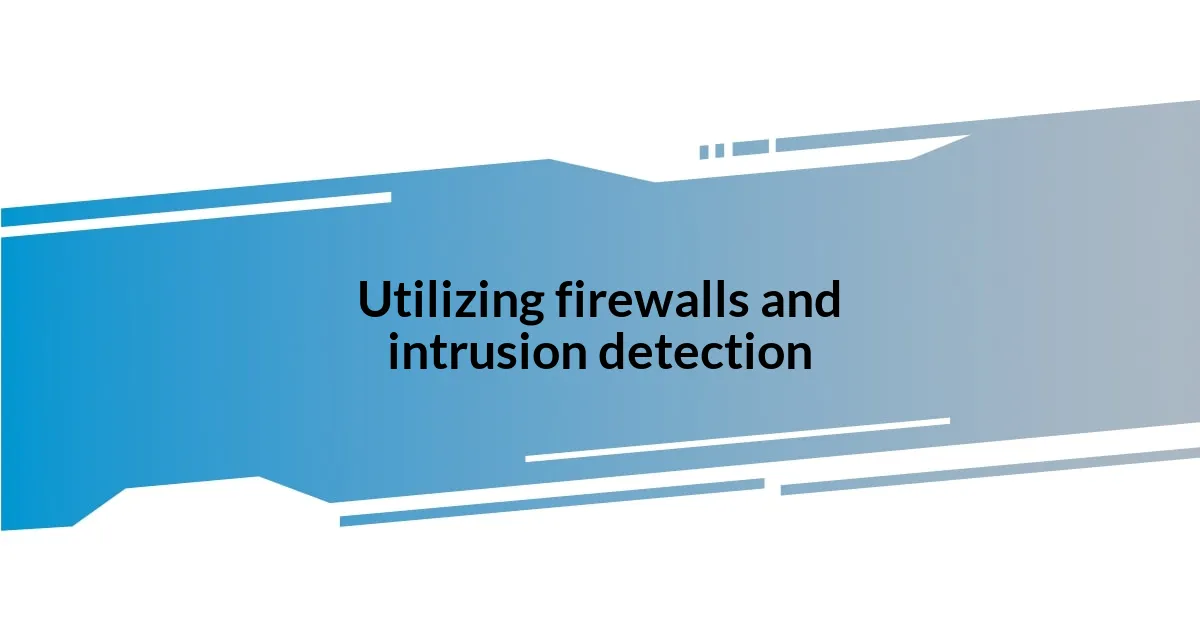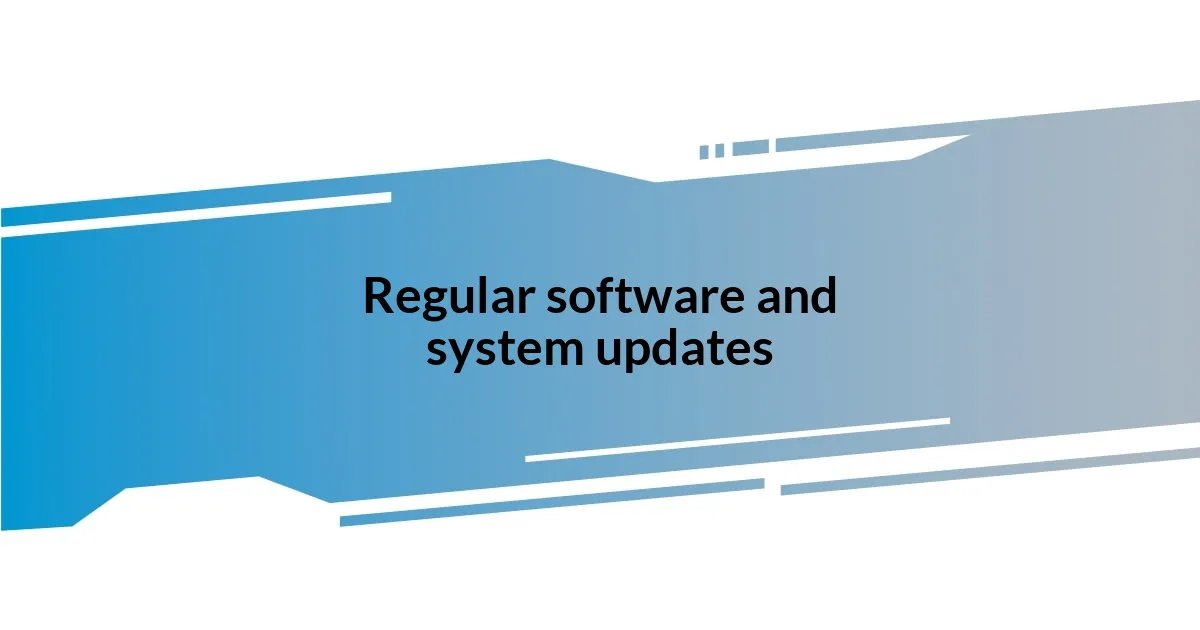Key takeaways:
- Implementing least privilege access reduces the risk of data breaches by limiting user access to only necessary information.
- A well-crafted security policy enhances employee awareness, establishes clear incident response protocols, and evolves to combat new threats.
- Regular software updates are essential for closing vulnerabilities and enhancing security defenses against cyber threats.
- Ongoing training and awareness programs empower employees to recognize and respond to potential security threats effectively.

Understanding network security concepts
When I first delved into the world of network security, I was struck by how foundational concepts like firewalls, encryption, and intrusion detection really are. It’s fascinating to think about how these elements work together to create a digital fortress, protecting sensitive data from unwanted access. Have you ever considered just how much trust we put in these invisible barriers and technologies?
One of the most eye-opening moments in my journey was learning about the concept of least privilege access. This idea teaches that users should only have access to the information and resources necessary for their roles. I recall a time when implementing this principle drastically reduced the risk of a data breach at my workplace. It made me realize how something as simple as limiting access could have such profound implications for security.
It’s also crucial to understand the role of incident response in network security. After experiencing a security incident firsthand, I learned that having a well-defined response plan can be the difference between a minor hiccup and a full-blown crisis. Can you imagine being caught off guard during an attack? The chaos that ensues can be overwhelming, but a solid plan allows teams to act quickly and effectively, lessening the impact.

Importance of a security policy
A well-crafted security policy serves as the backbone of any organization’s network security strategy. I’ve seen firsthand how having a clear policy can empower employees to understand their roles in protecting sensitive information. It creates a shared responsibility, a culture of vigilance, and can significantly decrease the likelihood of unintentional errors that lead to breaches.
Moreover, a security policy establishes clear guidelines for users, providing them with a framework for acceptable behavior within the network. I recall a scenario where a colleague accidentally clicked on a suspicious email attachment. Thankfully, our security policy was in place, and we had guidelines for reporting such incidents quickly, allowing our IT team to mitigate potential damage. Without that established protocol, the outcome could have been much worse.
Finally, consistent review and updates to the security policy help adapt to the ever-changing threat landscape. In my experience, our team’s ability to evolve our policy in response to new threats not only improved our defenses but also fostered a sense of trust among employees. They felt secure knowing we took their safety seriously and were proactive in our approach.
| Security Policy Benefits | Implications Without a Policy |
|---|---|
| Promotes a culture of security awareness | Increased risk due to lack of understanding |
| Establishes clear protocols for incident response | Confusion during security incidents |
| Enables regular updates to combat new threats | Vulnerability to evolving attacks |

Implementing strong password practices
Implementing strong password practices is essential in today’s digital landscape. Personally, I remember the frustration I felt when a loved one fell victim to a phishing attack simply because their password was weak and easily guessed. It drove home the point that strong passwords act as the first line of defense against unauthorized access. I always encourage people to think of passwords as the keys to their digital homes; if they’re easy to pick, anyone can get in uninvited.
Here are some effective practices to enhance password security:
- Use complex passwords: A combination of letters, numbers, and special characters makes passwords harder to crack.
- Avoid common words: Steer clear of easily guessed passwords like “password123” or personal details such as birthdays or names.
- Implement password managers: These tools help generate and store unique passwords for different accounts, minimizing the risk of reusing passwords.
- Enable multi-factor authentication (MFA): Adding an extra layer of security makes it even more difficult for attackers to gain access.
- Regularly update passwords: Changing your passwords periodically can help thwart potential infiltrators.
I’ve also found that setting reminders to change passwords keeps my accounts safer and gives me peace of mind. It’s about cultivating an ongoing habit of security that becomes second nature over time.

Utilizing firewalls and intrusion detection
When it comes to network security, utilizing firewalls is a non-negotiable step. I can remember the time when our company faced a massive influx of external threats. The firewall acted like a robust gatekeeper, monitoring traffic and blocking unwanted intrusions before they could even reach our network. It’s a comforting thought knowing that firewalls continuously analyze incoming and outgoing traffic, adding an essential layer of defense.
Intrusion detection systems (IDS) complement firewalls by identifying suspicious activities within the network. I once had a frightening experience where the IDS flagged a series of unusual login attempts. Our IT team was immediately alerted, enabling swift action to investigate and mitigate any potential breach. This is precisely why I believe having both firewalls and intrusion detection is crucial. They work together to not just defend but also to proactively spot threats. Have you ever felt that rush of relief when you know someone is on watch, keeping you safe? That’s what a well-integrated security setup provides—peace of mind.
Additionally, it’s vital to regularly update and configure both firewalls and IDS. I’ve learned firsthand that neglecting these systems can leave vulnerabilities open to exploitation. In fact, I once neglected an update, and it cost us dearly. The lesson here is straightforward: make updating these defenses a routine. It turns a reactive security approach into a proactive one, continuously adapting to evolving cyber threats and ensuring your network remains tightly secured.

Regular software and system updates
Regular software and system updates are crucial yet often overlooked in network security. I recall a time when I neglected to update my antivirus software. It didn’t take long for malware to sneak in, causing chaos on my computer. That experience taught me the hard way that delays in updates can create windows of opportunity for cybercriminals.
With each update, software developers address vulnerabilities and enhance security features. I often emphasize to my colleagues how staying current is like fortifying a wall—each update adds another layer of protection. It’s amazing to see how a simple click to update can safeguard us from potential threats lurking in the digital shadows. Have you ever felt that weight lift off your shoulders when you know you’ve taken steps to defend against potential attacks? That sense of security is worth every bit of effort.
In my experience, setting reminders for regular updates has been incredibly beneficial. It keeps security top of mind and transforms what could easily become a tedious task into a welcomed ritual. I find that when updates become part of our routine, they not only enhance our defenses but also foster a culture of vigilance within our teams. Why risk an unsecured system when a simple, proactive approach can continuously protect you?

Training staff on security awareness
Training staff on security awareness is pivotal in establishing a robust network security framework. I once led a workshop on this topic and was surprised by how many employees were unaware of basic phishing tactics. It was enlightening to see the shift in awareness as we went through real-life examples; suddenly, they were able to recognize potential threats in their inboxes. Have you experienced that moment of realization when a new piece of knowledge suddenly clicks? It’s that transformative understanding that I strive to foster through security training.
I believe that interactive training sessions make a significant impact. One memorable exercise involved simulating phishing attempts and inviting staff to share their thoughts in real-time. The laughter and gasps as they spotted the traps were mixed with genuine concern for their own data security. I noticed how this openness created a supportive environment; it empowered them to ask questions and engage on a personal level with the material. Isn’t it incredible how a little interaction can turn a dry subject into something relatable?
Moreover, ongoing training is essential, not just a one-time event. I’ve found that regular refresher courses foster a culture of continuous learning. During these sessions, I encourage sharing stories about security breaches, which not only keeps the training relevant but also humanizes the risks involved. After all, when everyone feels accountable, it transforms how we perceive network security. Are we not all in this together, working as a team to guard our digital environment? This shared responsibility not only strengthens our defenses but also builds a community around security awareness.

Monitoring and responding to threats
Monitoring network security in real-time is like keeping watch on a bustling city; it requires constant vigilance. I once implemented a monitoring tool in my network and was amazed at how it illuminated hidden activities. Just last month, during a routine check, I noticed unusual data traffic patterns that raised a red flag. It turned out to be a bot attempting to breach our defenses. Have you ever felt that rush of adrenaline when you catch something just before it becomes a problem? Quick action can make all the difference.
In my experience, an effective response plan is just as important as monitoring. I vividly recall a situation where an attempted breach occurred on a Friday night. My team and I had rehearsed our response protocol, and that preparation paid off. We quickly mitigated the threat and effectively communicated the situation to everyone involved, reducing panic and confusion. Isn’t it reassuring to have a clear action plan in place? That confidence allows you and your team to focus on what truly matters—protecting your data and your reputation.
It’s crucial to actually analyze the threats you encounter, too. After resolving incidents, I always conduct a debrief to understand what happened and how we can improve. This reflective practice not only enhances our security measures but also strengthens our team dynamics. I can’t emphasize enough how this iterative learning process fosters resilience. When was the last time you learned something valuable from a situation gone awry? It’s those lessons that shape our future security strategies and make us even more prepared for the challenges ahead.